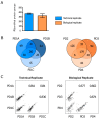Proteomics Profiling of Neuron-Derived Small Extracellular Vesicles from Human Plasma: Enabling Single-Subject Analysis
- PMID: 33799461
- PMCID: PMC7999506
- DOI: 10.3390/ijms22062951
Proteomics Profiling of Neuron-Derived Small Extracellular Vesicles from Human Plasma: Enabling Single-Subject Analysis
Abstract
Small extracellular vesicles have been intensively studied as a source of biomarkers in neurodegenerative disorders. The possibility to isolate neuron-derived small extracellular vesicles (NDsEV) from blood represents a potential window into brain pathological processes. To date, the absence of sensitive NDsEV isolation and full proteome characterization methods has meant their protein content has been underexplored, particularly for individual patients. Here, we report a rapid method based on an immunoplate covalently coated with mouse monoclonal anti-L1CAM antibody for the isolation and the proteome characterization of plasma-NDsEV from individual Parkinson's disease (PD) patients. We isolated round-shaped vesicles with morphological characteristics consistent with exosomes. On average, 349 ± 38 protein groups were identified by liquid chromatography-tandem mass spectrometry (LC-MS/MS) analysis, 20 of which are annotated in the Human Protein Atlas as being highly expressed in the brain, and 213 were shared with a reference NDsEV dataset obtained from cultured human neurons. Moreover, this approach enabled the identification of 23 proteins belonging to the Parkinson disease KEGG pathway, as well as proteins previously reported as PD circulating biomarkers.
Keywords: L1CAM; NES cells; Parkinson’s disease; central nervous system; exosomes; miR-155; neuron-derived vesicles; plasma; proteomics; small extracellular vesicles.
Conflict of interest statement
The authors declare no conflict of interest
Figures




Similar articles
-
[Tandem mass tag-based quantitative proteomics analysis of plasma and plasma exosomes in Parkinson's disease].Se Pu. 2023 Dec;41(12):1073-1083. doi: 10.3724/SP.J.1123.2022.12022. Se Pu. 2023. PMID: 38093537 Free PMC article. Chinese.
-
Rapid Isolation of Extracellular Vesicles from Blood Plasma with Size-Exclusion Chromatography Followed by Mass Spectrometry-Based Proteomic Profiling.Methods Mol Biol. 2017;1660:295-302. doi: 10.1007/978-1-4939-7253-1_24. Methods Mol Biol. 2017. PMID: 28828666 Free PMC article.
-
Proteomic analysis of cerebrospinal fluid extracellular vesicles: a comprehensive dataset.J Proteomics. 2014 Jun 25;106:191-204. doi: 10.1016/j.jprot.2014.04.028. Epub 2014 Apr 24. J Proteomics. 2014. PMID: 24769233
-
Plasma neuronal exosomes serve as biomarkers of cognitive impairment in HIV infection and Alzheimer's disease.J Neurovirol. 2019 Oct;25(5):702-709. doi: 10.1007/s13365-018-0695-4. Epub 2019 Jan 4. J Neurovirol. 2019. PMID: 30610738 Free PMC article. Review.
-
Emerging MS-based platforms for the characterization of tumor-derived exosomes isolated from human biofluids: challenges and promises of MudPIT.Expert Rev Proteomics. 2017 Sep;14(9):757-767. doi: 10.1080/14789450.2017.1364629. Epub 2017 Aug 10. Expert Rev Proteomics. 2017. PMID: 28780902 Review.
Cited by
-
A new paradigm for diagnosis of neurodegenerative diseases: peripheral exosomes of brain origin.Transl Neurodegener. 2022 May 9;11(1):28. doi: 10.1186/s40035-022-00301-5. Transl Neurodegener. 2022. PMID: 35527262 Free PMC article. Review.
-
Differential Effects of APOE Genotype on MicroRNA Cargo of Cerebrospinal Fluid Extracellular Vesicles in Females With Alzheimer's Disease Compared to Males.Front Cell Dev Biol. 2022 Apr 27;10:864022. doi: 10.3389/fcell.2022.864022. eCollection 2022. Front Cell Dev Biol. 2022. PMID: 35573689 Free PMC article.
-
Alpha-2-macroglobulin as a novel diagnostic biomarker for human bladder cancer in urinary extracellular vesicles.Front Oncol. 2022 Sep 13;12:976407. doi: 10.3389/fonc.2022.976407. eCollection 2022. Front Oncol. 2022. PMID: 36176383 Free PMC article.
-
CNS cell-derived exosome signatures as blood-based biomarkers of neurodegenerative diseases.Front Neurosci. 2024 Jun 20;18:1426700. doi: 10.3389/fnins.2024.1426700. eCollection 2024. Front Neurosci. 2024. PMID: 38966760 Free PMC article. Review.
-
The Neuromuscular Disorder Mediated by Extracellular Vesicles in Amyotrophic Lateral Sclerosis.Curr Issues Mol Biol. 2024 Jun 14;46(6):5999-6017. doi: 10.3390/cimb46060358. Curr Issues Mol Biol. 2024. PMID: 38921029 Free PMC article. Review.
References
-
- Harms A.S., Thome A.D., Yan Z., Schonhoff A.M., Williams G.P., Li X., Liu Y., Qin H., Benveniste E.N., Standaert D.G. Peripheral monocyte entry is required for alpha-Synuclein induced inflammation and Neurodegeneration in a model of Parkinson disease. Exp. Neurol. 2018;300:179–187. doi: 10.1016/j.expneurol.2017.11.010. - DOI - PMC - PubMed
MeSH terms
Substances
LinkOut - more resources
Full Text Sources
Other Literature Sources
Medical

